Akalabeth
 The Game: You start the game by creating a character, Basic D&D style, who enters the world defenseless and just this side of naked. It’s your job to arm and armor your alter-ego, buy plenty of rations, and then set out to explore the world of Britannia, and the treacherous dungeons that lie beneath it. A visit to the castle of Lord British will give you a chance to level up for deeds accomplished, and receive an assignment from him for your next adventure. (California Pacific Computer, 1980)
The Game: You start the game by creating a character, Basic D&D style, who enters the world defenseless and just this side of naked. It’s your job to arm and armor your alter-ego, buy plenty of rations, and then set out to explore the world of Britannia, and the treacherous dungeons that lie beneath it. A visit to the castle of Lord British will give you a chance to level up for deeds accomplished, and receive an assignment from him for your next adventure. (California Pacific Computer, 1980)
Memories: Like so many amateur-programmed Apple II games at the dawn of the 1980s, Akalabeth was distributed via floppy disk in a plastic bag with modest documentation and packaging. So what makes it so special now? Simply put, Akalabeth was also the dawn of a gaming empire – or the origin of one. It was the first computer game programmed and released by Richard Garriott, an avid fan of paper-and-dice role playing games with medieval settings. Both the game and its creator would transform over time – the basic structure of Akalabeth became the basis of the early Ultima games, and Garriott of course became known as his alter ego, the benevolent ruler of the Ultima universe, Lord British. [read more]

 The Game: You find yourself outside an inviting two-story house, and when you go in, you find several people waiting for you – and that inviting front door suddenly locked behind you. When dead bodies turn up on the second floor and night begins to fall (hope you found the matches in the cupboard already!), it quickly becomes apparent that among the friendly faces of the first floor is a cold-blooded killer. (On-Line Systems, 1980)
The Game: You find yourself outside an inviting two-story house, and when you go in, you find several people waiting for you – and that inviting front door suddenly locked behind you. When dead bodies turn up on the second floor and night begins to fall (hope you found the matches in the cupboard already!), it quickly becomes apparent that among the friendly faces of the first floor is a cold-blooded killer. (On-Line Systems, 1980)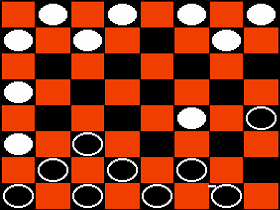 The Game: The classic game of strategy is faithfully reproduced on the Apple II. Two armies of twelve men each advance diagonally across the checkerboard, jumping over opponents and attempting to reach the enemy’s home squares to be crowned. Whoever still has pieces still standing at the end of the game wins. (Odessa Software, 1981)
The Game: The classic game of strategy is faithfully reproduced on the Apple II. Two armies of twelve men each advance diagonally across the checkerboard, jumping over opponents and attempting to reach the enemy’s home squares to be crowned. Whoever still has pieces still standing at the end of the game wins. (Odessa Software, 1981)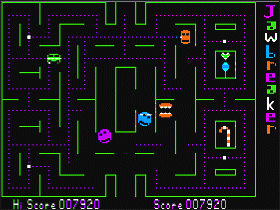 The Game: You’re a mobile set of chattering teeth, gobbling up goodies in a maze as jaw-breaking candies pursue you. If you bite down on one of these killer candies, you’ll rack up quite a dental bill (enough to lose a life). You can snag one of four snacks in the corners of the maze and suddenly the tooth-rotting treats become crunchy and vulnerable. Advance to the next level by clearing the maze of dots. (On-Line Systems, 1981)
The Game: You’re a mobile set of chattering teeth, gobbling up goodies in a maze as jaw-breaking candies pursue you. If you bite down on one of these killer candies, you’ll rack up quite a dental bill (enough to lose a life). You can snag one of four snacks in the corners of the maze and suddenly the tooth-rotting treats become crunchy and vulnerable. Advance to the next level by clearing the maze of dots. (On-Line Systems, 1981) The Game: As a round white creature consisting of a mouth and nothing else, and apparently somehow tied to the Internal Revenue Service, you maneuver around a relatively simple maze, gobbling small dots and evading four colorful monsters who can eat you on contact. In four corners of the screen, large flashing dots enable you to turn the tables and eat the monsters for a brief period for an escalating score. Periodically, assorted items appear near the center of the maze, and you can consume these for additional points as well. The monsters, once eaten, return to their home base in ghost form and, after spending some noncorporeal time floating around and contemplating taxation without representation, return to chase you anew. If cleared of dots, the maze refills and the game starts again, but just a little bit faster… (H.A.L. Labs, 1981)
The Game: As a round white creature consisting of a mouth and nothing else, and apparently somehow tied to the Internal Revenue Service, you maneuver around a relatively simple maze, gobbling small dots and evading four colorful monsters who can eat you on contact. In four corners of the screen, large flashing dots enable you to turn the tables and eat the monsters for a brief period for an escalating score. Periodically, assorted items appear near the center of the maze, and you can consume these for additional points as well. The monsters, once eaten, return to their home base in ghost form and, after spending some noncorporeal time floating around and contemplating taxation without representation, return to chase you anew. If cleared of dots, the maze refills and the game starts again, but just a little bit faster… (H.A.L. Labs, 1981) The Game: You are go for landing on the moon – only the moon isn’t there to make it easy for you. Craggy mountains and craters make it difficult for you to find one of the few safe landing spots on the surface, and even when you’re aligned above level ground, your fuel is running out fast. Do you have the right stuff that it’ll take before you can take one giant leap? (Bill Budge, 1981 / re-released by Eduware in 1984)
The Game: You are go for landing on the moon – only the moon isn’t there to make it easy for you. Craggy mountains and craters make it difficult for you to find one of the few safe landing spots on the surface, and even when you’re aligned above level ground, your fuel is running out fast. Do you have the right stuff that it’ll take before you can take one giant leap? (Bill Budge, 1981 / re-released by Eduware in 1984)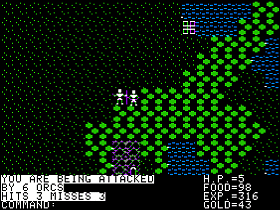 The Game: You set out alone on an adventure spanning countryside, mountains, oceans, towns and dungeons. You can purchase food rations, weapons and armor in the towns, visit Lord British in a castle for his wisdom, maybe a level-up, and your next assignment, or you can venture forth into the dungeons to test your skill against the denizens of the underworld. (California Pacific Computer, 1981)
The Game: You set out alone on an adventure spanning countryside, mountains, oceans, towns and dungeons. You can purchase food rations, weapons and armor in the towns, visit Lord British in a castle for his wisdom, maybe a level-up, and your next assignment, or you can venture forth into the dungeons to test your skill against the denizens of the underworld. (California Pacific Computer, 1981) The Game: Players control a spy sneaking through a building looking for secret information. High-speed elevators zoom up and down their cables throughout each floor at random intervals, making it difficult to accomplish the goal of crossing to the other side of the screen (the only way to ascend to the next floor). It takes skill, timing and nerves of steel to keep one’s spies from their demise. (Penguin Software, 1982)
The Game: Players control a spy sneaking through a building looking for secret information. High-speed elevators zoom up and down their cables throughout each floor at random intervals, making it difficult to accomplish the goal of crossing to the other side of the screen (the only way to ascend to the next floor). It takes skill, timing and nerves of steel to keep one’s spies from their demise. (Penguin Software, 1982)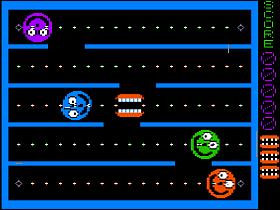 The Game: Ever had a sweet tooth? Now you are the sweet tooth – or teeth, as the case may be. You guide a set of clattering teeth around a mazelike screen of horizontal rows; an opening in each row travels down the wall separating it from the next row. Your job is to eat the tasty treats lining each row until you’ve cleared the screen. Naturally, it’s not just going to be that easy. There are nasty hard candies out to stop you, and they’ll silence those teeth of yours if they catch you – and that just bites. Periodically, a treat appears in the middle of the screen allowing you to turn the tables on them for a brief interval. Sierra On-Line, 1982
The Game: Ever had a sweet tooth? Now you are the sweet tooth – or teeth, as the case may be. You guide a set of clattering teeth around a mazelike screen of horizontal rows; an opening in each row travels down the wall separating it from the next row. Your job is to eat the tasty treats lining each row until you’ve cleared the screen. Naturally, it’s not just going to be that easy. There are nasty hard candies out to stop you, and they’ll silence those teeth of yours if they catch you – and that just bites. Periodically, a treat appears in the middle of the screen allowing you to turn the tables on them for a brief interval. Sierra On-Line, 1982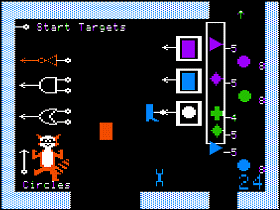 The Game: Rocky is trying to build machines to kick stuff. He provides players with a number of connectors and components, and shows them how they can be used to achieve different tasks. (The Learning Company, 1982)
The Game: Rocky is trying to build machines to kick stuff. He provides players with a number of connectors and components, and shows them how they can be used to achieve different tasks. (The Learning Company, 1982)